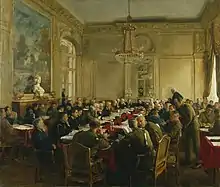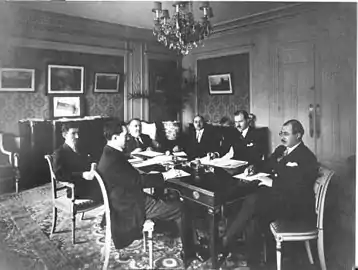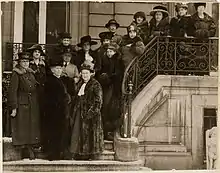
The Paris Peace Conference gathered over 30 nations at the Quai d'Orsay in Paris, France, to shape the future after World War I. The Russian SFSR was not invited to attend, having already concluded a peace treaty with the Central Powers in the spring of 1918. The Central Powers - Austria-Hungary, Germany, Bulgaria and the Ottoman Empire - were not allowed to attend the conference until after the details of all the peace treaties had been elaborated and agreed upon. The main result of the conference was the Treaty of Versailles with Germany.
Signing delegations

This list shows all nations and delegations who signed the Treaty of Versailles. All plenipotentiaries signed the treaty, except where indicated otherwise.[1]
Other national representatives


Despite not signing the treaties, other delegations were sent to the Paris Peace Conferences, some uninvited, in order to represent their national interests.
| Nation | Representatives | Notes | |
|---|---|---|---|
| Faisal Lawrence of Arabia | Faisal, later King of Iraq, advocated for an independent Arab state. T.E. Lawrence acted as the delegation's translator.[2][3] | ||
| Avetis Aharonian Hamo Ohanjanyan Armen Garo | |||
| National Committee of the Pindus | Attempted to establish an autonomous Aromanian entity.[4] | ||
| Bishop Aphrem Baroum | Attempted to establish an autonomous Assyrian entity in the Assyrian homeland.[5] | ||
| Alimardan bey Topchubashov | |||
| Anton Luckievich | Attempted to gain international recognition of the independence of Belarus.[6] | ||
| Jaan Poska Nikolai Köstner Jaan Tõnisson Ants Piip Karl Robert Pusta Mihkel Martna Eduard Laaman Joakim Puhk | Attempted to gain recognition of the independence of Estonia.[7][8] | ||
| Nikolay Chkheidze Irakli Tsereteli Zurab Avalishvili | |||
| Seán T. O'Kelly | The unrecognized Irish Republic sent representatives in hope the republic declared at the Easter Rising in 1916 would be recognised, but they were ignored.[9][10] | ||
| Kim Kyu-sik | Representing the Provisional Government of the Republic of Korea, in-exile in China.[11] | ||
| Jānis Čakste | Attempted to gain recognition of the independence of Latvia.[7][12] | ||
| Elias Peter Hoayek | Attempted to gain recognition of the independence of Lebanon. | ||
| Augustinas Voldemaras Antanas Smetona | Attempted to gain recognition of the independence of Lithuania.[7][13] | ||
| Nicholas I of Montenegro | The unification of Serbia and Montenegro on 18 November 1918 was contested by the exiled king of Montenegro. Despite Italian support, Montenegro was denied an official seat at the Peace Conferences, and the unification of Serbia and Montenegro was recognised.[14] | ||
| William F. Lloyd | [15] | ||
| Abdulmajid Tapa Tchermoeff | |||
| Sergey Sazonov | The Allied Powers refused to recognise the Bolshevik government of Russia, and instead invited representatives of the Russian Provisional Government (chaired by Prince Lvov), the successor to the Russian Constituent Assembly and the political arm of the Russian White movement.[16][17] | ||
| M. Bucquet | [18] | ||
| Lobbied for the independence of Tripolitania from Italian Libya.[19] | |||
| Hryhorii Sydorenko Mykhailo Tyshkevych | Lobbied for the independence of Ukraine and for support in its war against Russia.[20] | ||
| Ho Chi Minh | Ho Chi Minh petitioned the conference, seeking self determination and independence for the Vietnamese people.[21][22] | ||
| Vasyl Paneiko | Lobbied for the independence of West Ukraine.[20] |
Non-national representatives

Other non-national or pan-national delegations were in Paris, hoping to petition the allies on issues relating to their causes.
| Group | Major People | Notes |
|---|---|---|
| 1st Pan-African Congress | W. E. B. Du Bois Ida Gibbs | Held in February 1919 in order to petition the allies on African issues. |
| Inter-Allied Women's Conference | Marguerite de Witt-Schlumberger | Convened and met from 10 February to 10 April 1919. |
| Dr. Chaim Weizmann | Lobbied for the establishment of a Jewish state in Palestine.[23] |
Oversights
An oft-stated myth is that the Principality of Andorra was not invited to attend, due to an 'oversight' and that the issue of Andorra being at war was eventually resolved on September 24, 1958, when a peace treaty was signed. This claim first appeared in North American newspapers in 1958[24][25] and has been repeated since.[26][27] In reality, Andorra did not officially participate in World War I.[28] In 2014, the news outlet Ràdio i Televisió d'Andorra investigated the 1958 claim and could find no documentation of any original declaration of war. Historian Pere Cavero could only find an exchange of letters between the German consul in Marseille and the Catalan Ombudsman, where the former asks if there is a state of war with Andorra and the latter responds they could find nothing in their archive to indicate this.[29]
References
- ↑ . 1919 – via Wikisource.
- ↑ "The Middle Eastern Prince Who Tried to Change the Treaty of Versailles". The Saturday Evening Post. 2019-06-28. Retrieved 2020-10-08.
- ↑ "Story Map Journal". www.arcgis.com. Retrieved 2020-10-08.
- ↑ Motta, Giuseppe (2011). "The Fight for Balkan Latinity. The Aromanians until World War I" (PDF). Mediterranean Journal of Social Sciences. 2 (3): 252–260. doi:10.5901/mjss.2011.v2n3p252. ISSN 2039-2117.
- ↑ Lundgren, Svante (2020). "Why did the Assyrian lobbying at the Paris Peace Conference fail?" (PDF). Chronos: Revue d'Histoire de l'Université de Balamand: 63–73.
- ↑ Моладзь БНФ. "Чатыры ўрады БНР на міжнароднай арэне ў 1918–1920 г." Archived from the original on 3 July 2013. Retrieved 30 September 2015.
- 1 2 3 Trapans, Jan Arveds (1994). "The West and the Recognition of the Baltic States: 1919 and 1991. A Study of the Politics of the Major Powers". Journal of Baltic Studies. 25 (2): 153–173. doi:10.1080/01629779400000071. ISSN 0162-9778. JSTOR 43211894.
- ↑ "Estonian Ministry of Foreign Affairs / Välisministeerium". www.facebook.com. Retrieved 2020-10-08.
- ↑ Gannon, Darragh. "January 1919: the Irish Republic, the League of Nations and a new world order". The Conversation. Retrieved 2020-10-08.
- ↑ "Ireland and the Paris Peace Conference: How Sinn Féin Waged a Diplomatic War". IrishCentral.com. 2017-02-03. Retrieved 2020-10-08.
- ↑ "Wilson Center Digital Archive". digitalarchive.wilsoncenter.org. Retrieved 2020-10-08.
- ↑ Bražūne, Alda. "THE ROLE OF FRANCE IN THE FOREIGN POLICY OF LATVIA, 1921-1933" (PDF). Retrieved 2020-10-09.
- ↑ "The state of Lithuania placing itself on the international stage in 1918–1924". valstybingumas.lt. Retrieved 2020-10-08.
- ↑ Pećinar. "The Paris Peace Conference — Contemporary Balkans' perspective" (PDF). Retrieved 2020-10-09.
- ↑ "William F. Lloyd". memim.com. Retrieved 2020-10-08.
- ↑ "First World War.com - Who's Who - Sergei Sazonov". www.firstworldwar.com. Retrieved 2020-10-08.
- ↑ Department Of State. The Office of Electronic Information, Bureau of Public Affairs (2007-08-01). "The Paris Peace Conference and the Treaty of Versailles". 2001-2009.state.gov. Retrieved 2020-10-08.
- ↑ "The Project Gutenberg eBook of THE INSIDE STORY OF THE PEACE CONFERENCE, by Dr. E.J. Dillon". www.gutenberg.org. Retrieved 2020-10-08.
- ↑ "Tripolitania, Italian Colony (1922 - 1934)". Dead Country Stamps and Banknotes. 2014-01-04. Retrieved 2022-05-05.
- 1 2 "Paris Peace Conference". www.encyclopediaofukraine.com. Retrieved 2022-02-28.
- ↑ "Ho Chi Minh seeks Vietnamese independence (1919)". alphahistory.com. 20 April 2016. Retrieved 2020-10-09.
- ↑ Bria, Maggie (2017-03-30). "What Did the 1919 Paris Peace Conference Have to Do with the Vietnam War?". Bria Historica. Retrieved 2020-10-09.
- ↑ "Papers Relating to the Foreign Relations of the United States, The Paris Peace Conference, 1919, Volume IV - Office of the Historian". history.state.gov. Retrieved 2022-02-28.
- ↑ "44-Year Mystery War Ends". St. Louis Globe-Democrat. Newhouse Newspapers. 19 September 1958. p. 20.
- ↑ "World War I Ends in Andorra". The New York Times. United Press International. 25 September 1958. p. 66.
- ↑ Reich, Herb (2012). Lies They Teach in School: Exposing the Myths Behind 250 Commonly Believed Fallacies. New York: Skyhorse Publication, Inc. p. 52. ISBN 978-1616085964.
- ↑ E.g., "Skin-flicks in Shangri-La", The Economist, 1974; Time, 1960.
- ↑ Guillamet Anton, Jordi (2009). Nova aproximació a la història d'Andorra. ALTAIR. p. 216. ISBN 978-8493622046.
- ↑ "Andorra va declarar la guerra a Alemanya el 1914?". AndorraDifusió. Ràdio i Televisió d'Andorra. 4 February 2014. Retrieved 12 March 2021.